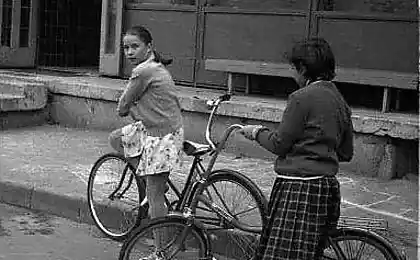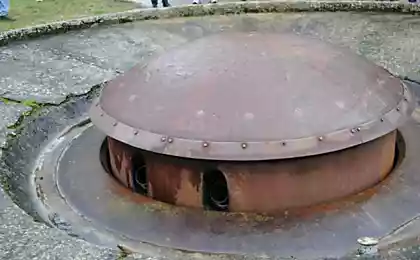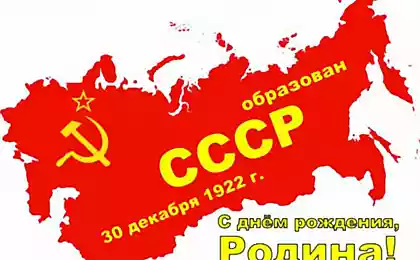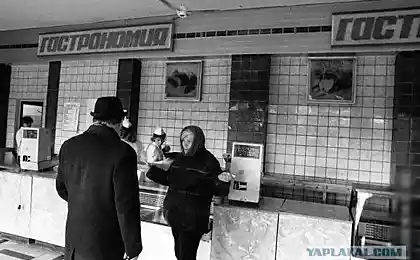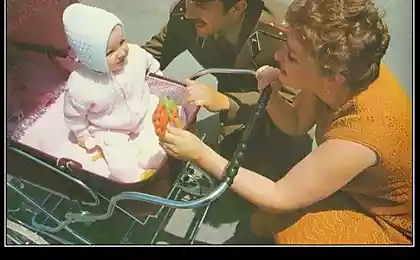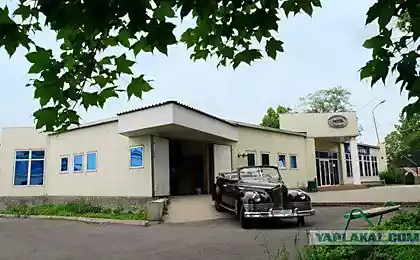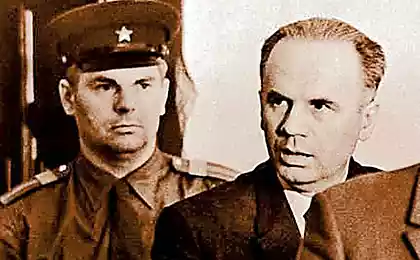1273
the USSR
The popular revolts in the USSR
(unknown pages of history)
On the popular uprisings against tsarist written quite a lot. And about these situations in the Soviet Union, we had no one reported. It was believed that in a socialist society achieved "complete ideological and political unity" and, of course, about any popular revolts and can be no question. The Programme of the CPSU was even written, that from the point of view of the internal problems of the Soviet Union in the military does not need. In fact, it was not so. The struggle between the people and the authorities in the country continued. Now entered into scientific circulation Documents allow to recreate a picture of popular resistance under Stalin and in the post-Stalin period. In this sense, of great interest is the study of Nicholas Zenkovich "Secrets of the past century" (Bk. 2) and a collection of documents "The Communist regime and the popular resistance in Russia. 1917-1991 "(Library of Russian studies, Issue 1). These works, along with other were used in preparing this article.
About the guerrilla movement in the Baltics, the Caucasus, in the western regions of Ukraine and Belarus posted a lot of interesting work. But today we learn that the resistance of the authorities was not only there. During the reign of Stalin, in spite of the mass terror, the resistance did not cease, and in other regions of the country. It should be noted that during this period due to the specific conditions of life of the country, pockets of resistance were concentration camps. Naturally, the rest of the population about it knew nothing. Information about the uprisings were strict state secret.
June 11, 1957 in Podolsk there were 7000 people performance against the militia. 9 ringleaders were convicted. In January 1961, clashes with the police took place in Krasnodar, then in Biisk Altai Territory. In June of the same year - in Murom, in July - in Aleksandrovsk (both - in the Vladimir region). 15 and September 16, 1961 - Unrest in Beslan in North Ossetia.
3 and 4 July 1962 happening uprising in Novocherkassk, Rostov region. 4000 workers staged a demonstration Electric Locomotive Plant protest due to higher prices for meat and oil. The protesters dispersed with the help of troops. 23 people were killed, 70 - injured. In the criminal charges brought against 132 instigator.
In 1963, the recorded speech in Krivoy Rog and Sumgait (Azerbaijan). In the last four people were killed, 15 - injured, 41 put on trial. 1967: seven major performances in Central Asia, Belarus, Ukraine, Azerbaijan, Kabardino-Balkaria. There were casualties. Many prosecuted.
In January 1977 riots and confrontation of the police recorded in Novomoskovsk, Tula Region.
In October 1981 - in Ordzhonikidze, North Ossetian ASSR. The list goes on.
Particularly acute were conflicts on ethnic basis. For example, in January 1985 in the capital of Tajikistan, Dushanbe broke a fight between Tajik and Russian. Both sides involved up to 700 people. But the biggest clash on a national basis was, of course, carnage in Almaty on 17-18 December 1986. The unrest was attended by about 5000 people. "The nationalist students of a number of higher educational institutions of the city ... expressed demands to revise the decision of the Plenum of the Central Committee of the Communist Party of the republic ... then first secretary of the Communist Party of Kazakhstan Kunaev was replaced Russian - Kolbin. During the riots were injured 1215 people, including 774 soldiers and police officers ... In this case criminal proceedings were brought 107 people, "- emphasizes N. Zenkovich. Even Distant Yakutia has not gone away. In April 1986, in Yakutsk 600 people participated in the encounter, the Battle between the Russian and the Yakut youth.
Summing up, Chebrikov in the "Help" noted that 30 years after the war recorded 24 cases of mass riots against the government. In 11 cases, the suppression of the weapons used, resulting in 43 people were killed and 166 wounded. Against the 600 criminal cases were initiated.
During this same time for anti-Soviet agitation and propaganda have been convicted person 6543 under article 70 of the Criminal Code of the RSFSR, and in 1609 under Article 190 of the Criminal Code of the RSFSR approx. It goes without saying that all these events could not but reflect on the army as part of Soviet society. In June 1953, during the uprising of workers in East Germany, the Soviet Army soldiers refused to fire on the rebels. In this regard, 18 soldiers were killed near Magdeburg, and 23 in Berlin. "Among those shot were Sergeant Nicholas Tyulyakov, Corporal Alexander Shcherbina and Private Vasily Dyatkovo. Names of other known ", - reported in the book" The Communist regime ... & quot;
But even before this case, it is argued in the same collection, in 1947 there was an uprising on the cruiser "Kalinin" Pacific Fleet. The ship tried to escape to Japan. The revolt was suppressed. Many sailors and officers were shot.
In 1955 it broke out in Vladivostok and was brutally suppressed the uprising on the cruiser "Dmitry Donskoy". For information about these performances are scarce. The degree of secrecy was so high that the documents remained small. Even the names of the personnel of the establishment of these vehicles is the difficulty.
But the events of 1975 is well known enough. Head of the opposition to the regime of Brezhnev was Valery Sablin, a native Nizhni Novgorod. With the support of the crew, he rebelled on the latest anti-submarine ship "Watchdog" and challenged the whole repressive party-state machine of the USSR. Captain 3rd Rank Valery Sablin, deputy commander for political affairs, a graduate of the Military Political Academy named after Lenin, protesting against the Brezhnev regime arrested the captain, arbitrarily withdrew from the raid in Riga and led the ship to Leningrad, to appear on television and call upon the Soviet people to indefinite strike. A large part of the crew supported the rebel political officer. "Supreme Commander Leonid Brezhnev, after hearing the report of the Minister of Defence, decides to raise the aircraft into the air. Planes bombed the course of the ship. He stops the car, the rebels are arrested ... ", - said N. Zenkovich.
At that time I had a chance to serve in Kaliningrad, located where the main base of the fleet (Baltic) and headquarters DKBF. But then there were rumors that Sablin tried to hijack the ship to Sweden. Apparently, the rumors were dismissed in order to confirm the "renegade" mood Sablina.
For clarity, we present a document marked "special folder».
"Reporting:
In the night from 8 to 9 January. the deputy commander for political anti-submarine ship "Watchdog" Captain 3 rank Sablin, born in 1939, Russian, graduated from the Military-Political Academy. Lenin in 1973 fraudulently isolated commander Captain 2nd Rank Potulnogo AV and win over the two officers and staff of 10-12 people, at 3.20 November 9 weighed anchor and left Riga in the Baltic Sea, announcing crew that should be in Kronstadt. In an order to return to base Sablin did not react. After warning shots and bombing at the rate of ship Air Force ship stopped. Forces personnel commander Captain 2nd Rank Potulny AV was released and took command. Sablin was arrested ... under investigation.
Grechko. November 10, 1975 ».
In the document filed in the event rosy. Sablin was supported by many.
Valery Sablin graduated in 1960 from the Higher Naval School named after Frunze and until 1969 served in combatant positions. Then he entered the Military-Political Academy, where he graduated in 1973. It was there that Sablin began to doubt the validity of the existing system. He was a competent, well-trained, well-read officer who respected officers and sailors. The ship arrived in Riga on a naval parade in honor of the anniversary of the revolution. That's where the political officer and decided to carry out his plan - to call upon the people to fight against the dictatorship of Brezhnev. He was married. I had a son. His father was a captain 1st rank stock.
In total the ship had 194 people, including 15 officers. We can not say that they were opposed to the existing system. Himself rebellious political officer and his supporters believed that the leadership of the CPSU has departed from Leninist principles of socialist construction. So consider them as dissidents in the strict sense of the word can not.
The massacre followed immediately. Captain 3rd Rank Sablin was sentenced to death. Sailor Shein - to 8 years imprisonment. The entire crew was disbanded and sent to the North and the Far East. Thus ended the saga.
In 1994, the Military Collegium of the Russian Supreme Court reviewed the case Sablina and "firing" article (for treason) was replaced by articles on military crimes: abuse of authority, disobedience and resistance to authorities.
"The act of pulling Sablina 10 years in prison and helped him sailor Shein - for five years. However, the judges decided to write a separate line that Sablin and Shein full rehabilitation can not be ", - said N. Zenkovich. But by the time Sablina has long been dead, and the sailor Shein fully served his sentence and was on the loose.
It is now known that the spring of 1946 a rebellion broke out in Kolyma, in Ustvymlage and Dzhezkazgan. The prisoners, knowing that the rebellion is doomed to failure, decided in harsh conditions to oppose the established order in the gulag. On the suppression of unrest were thrown troops. Hundreds of protesters were shot without trial.
It is known that after the war, hundreds of thousands of former military personnel for a variety of reasons contained in the camps. Experienced, do not know the fear of the soldiers had nothing to lose in that situation. They were enemies of Nazi Germany, and after his release from German captivity made them enemies of Russia. And in the summer of 1948 in the Pechora camps of thousands of prisoners, officers of the Soviet Army led Mehteeva rose and moved to Vorkuta. At the same time, prisoners were made in the construction of 501-503 (railway Labytnangi-Igarka), led by Voronin. The uprising was brutally suppressed: Hundreds of people were shot, and the rest are doomed to a slow death in the Arctic. In 1949-50. again there were uprisings in Kolyma ("Elgenugol"), Salekhard, Taishet. In April 1951 - in Kraslag. At the same time 64 people were killed. In January 1952 the prisoners starved 5000 in Ekibastuz. That same year, the prisoners rebelled in the Komi Republic and in the Krasnoyarsk Territory. Supervised performance Ershov. In 1953, the convicts went Norilsk, Vorkuta, Karaganda and Kolyma again.
One of the largest was the revolt of prisoners in 13 thousand Kengir led Kuznetsova. 42 days held the rebels. And they are only required to improve the conditions of detention and respect for the Soviet constitution. They even have prepared banners with slogans "Long live the Soviet Constitution!". Against them were thrown 3000 soldiers and tanks.

Novocherkask

Valery Sablin

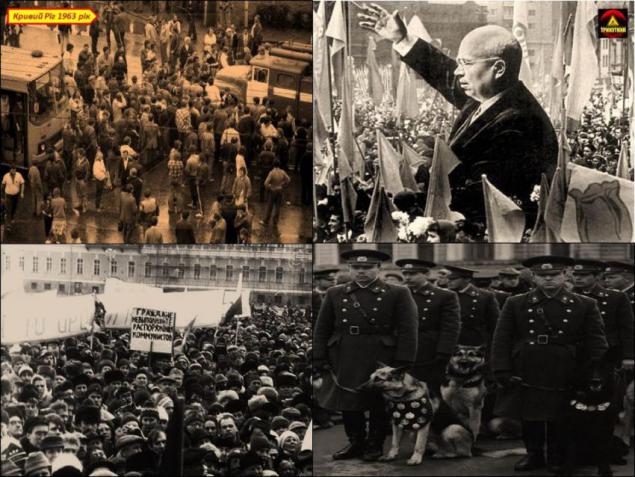
Source: www.russianmontreal.ca
(unknown pages of history)
On the popular uprisings against tsarist written quite a lot. And about these situations in the Soviet Union, we had no one reported. It was believed that in a socialist society achieved "complete ideological and political unity" and, of course, about any popular revolts and can be no question. The Programme of the CPSU was even written, that from the point of view of the internal problems of the Soviet Union in the military does not need. In fact, it was not so. The struggle between the people and the authorities in the country continued. Now entered into scientific circulation Documents allow to recreate a picture of popular resistance under Stalin and in the post-Stalin period. In this sense, of great interest is the study of Nicholas Zenkovich "Secrets of the past century" (Bk. 2) and a collection of documents "The Communist regime and the popular resistance in Russia. 1917-1991 "(Library of Russian studies, Issue 1). These works, along with other were used in preparing this article.
About the guerrilla movement in the Baltics, the Caucasus, in the western regions of Ukraine and Belarus posted a lot of interesting work. But today we learn that the resistance of the authorities was not only there. During the reign of Stalin, in spite of the mass terror, the resistance did not cease, and in other regions of the country. It should be noted that during this period due to the specific conditions of life of the country, pockets of resistance were concentration camps. Naturally, the rest of the population about it knew nothing. Information about the uprisings were strict state secret.
June 11, 1957 in Podolsk there were 7000 people performance against the militia. 9 ringleaders were convicted. In January 1961, clashes with the police took place in Krasnodar, then in Biisk Altai Territory. In June of the same year - in Murom, in July - in Aleksandrovsk (both - in the Vladimir region). 15 and September 16, 1961 - Unrest in Beslan in North Ossetia.
3 and 4 July 1962 happening uprising in Novocherkassk, Rostov region. 4000 workers staged a demonstration Electric Locomotive Plant protest due to higher prices for meat and oil. The protesters dispersed with the help of troops. 23 people were killed, 70 - injured. In the criminal charges brought against 132 instigator.
In 1963, the recorded speech in Krivoy Rog and Sumgait (Azerbaijan). In the last four people were killed, 15 - injured, 41 put on trial. 1967: seven major performances in Central Asia, Belarus, Ukraine, Azerbaijan, Kabardino-Balkaria. There were casualties. Many prosecuted.
In January 1977 riots and confrontation of the police recorded in Novomoskovsk, Tula Region.
In October 1981 - in Ordzhonikidze, North Ossetian ASSR. The list goes on.
Particularly acute were conflicts on ethnic basis. For example, in January 1985 in the capital of Tajikistan, Dushanbe broke a fight between Tajik and Russian. Both sides involved up to 700 people. But the biggest clash on a national basis was, of course, carnage in Almaty on 17-18 December 1986. The unrest was attended by about 5000 people. "The nationalist students of a number of higher educational institutions of the city ... expressed demands to revise the decision of the Plenum of the Central Committee of the Communist Party of the republic ... then first secretary of the Communist Party of Kazakhstan Kunaev was replaced Russian - Kolbin. During the riots were injured 1215 people, including 774 soldiers and police officers ... In this case criminal proceedings were brought 107 people, "- emphasizes N. Zenkovich. Even Distant Yakutia has not gone away. In April 1986, in Yakutsk 600 people participated in the encounter, the Battle between the Russian and the Yakut youth.
Summing up, Chebrikov in the "Help" noted that 30 years after the war recorded 24 cases of mass riots against the government. In 11 cases, the suppression of the weapons used, resulting in 43 people were killed and 166 wounded. Against the 600 criminal cases were initiated.
During this same time for anti-Soviet agitation and propaganda have been convicted person 6543 under article 70 of the Criminal Code of the RSFSR, and in 1609 under Article 190 of the Criminal Code of the RSFSR approx. It goes without saying that all these events could not but reflect on the army as part of Soviet society. In June 1953, during the uprising of workers in East Germany, the Soviet Army soldiers refused to fire on the rebels. In this regard, 18 soldiers were killed near Magdeburg, and 23 in Berlin. "Among those shot were Sergeant Nicholas Tyulyakov, Corporal Alexander Shcherbina and Private Vasily Dyatkovo. Names of other known ", - reported in the book" The Communist regime ... & quot;
But even before this case, it is argued in the same collection, in 1947 there was an uprising on the cruiser "Kalinin" Pacific Fleet. The ship tried to escape to Japan. The revolt was suppressed. Many sailors and officers were shot.
In 1955 it broke out in Vladivostok and was brutally suppressed the uprising on the cruiser "Dmitry Donskoy". For information about these performances are scarce. The degree of secrecy was so high that the documents remained small. Even the names of the personnel of the establishment of these vehicles is the difficulty.
But the events of 1975 is well known enough. Head of the opposition to the regime of Brezhnev was Valery Sablin, a native Nizhni Novgorod. With the support of the crew, he rebelled on the latest anti-submarine ship "Watchdog" and challenged the whole repressive party-state machine of the USSR. Captain 3rd Rank Valery Sablin, deputy commander for political affairs, a graduate of the Military Political Academy named after Lenin, protesting against the Brezhnev regime arrested the captain, arbitrarily withdrew from the raid in Riga and led the ship to Leningrad, to appear on television and call upon the Soviet people to indefinite strike. A large part of the crew supported the rebel political officer. "Supreme Commander Leonid Brezhnev, after hearing the report of the Minister of Defence, decides to raise the aircraft into the air. Planes bombed the course of the ship. He stops the car, the rebels are arrested ... ", - said N. Zenkovich.
At that time I had a chance to serve in Kaliningrad, located where the main base of the fleet (Baltic) and headquarters DKBF. But then there were rumors that Sablin tried to hijack the ship to Sweden. Apparently, the rumors were dismissed in order to confirm the "renegade" mood Sablina.
For clarity, we present a document marked "special folder».
"Reporting:
In the night from 8 to 9 January. the deputy commander for political anti-submarine ship "Watchdog" Captain 3 rank Sablin, born in 1939, Russian, graduated from the Military-Political Academy. Lenin in 1973 fraudulently isolated commander Captain 2nd Rank Potulnogo AV and win over the two officers and staff of 10-12 people, at 3.20 November 9 weighed anchor and left Riga in the Baltic Sea, announcing crew that should be in Kronstadt. In an order to return to base Sablin did not react. After warning shots and bombing at the rate of ship Air Force ship stopped. Forces personnel commander Captain 2nd Rank Potulny AV was released and took command. Sablin was arrested ... under investigation.
Grechko. November 10, 1975 ».
In the document filed in the event rosy. Sablin was supported by many.
Valery Sablin graduated in 1960 from the Higher Naval School named after Frunze and until 1969 served in combatant positions. Then he entered the Military-Political Academy, where he graduated in 1973. It was there that Sablin began to doubt the validity of the existing system. He was a competent, well-trained, well-read officer who respected officers and sailors. The ship arrived in Riga on a naval parade in honor of the anniversary of the revolution. That's where the political officer and decided to carry out his plan - to call upon the people to fight against the dictatorship of Brezhnev. He was married. I had a son. His father was a captain 1st rank stock.
In total the ship had 194 people, including 15 officers. We can not say that they were opposed to the existing system. Himself rebellious political officer and his supporters believed that the leadership of the CPSU has departed from Leninist principles of socialist construction. So consider them as dissidents in the strict sense of the word can not.
The massacre followed immediately. Captain 3rd Rank Sablin was sentenced to death. Sailor Shein - to 8 years imprisonment. The entire crew was disbanded and sent to the North and the Far East. Thus ended the saga.
In 1994, the Military Collegium of the Russian Supreme Court reviewed the case Sablina and "firing" article (for treason) was replaced by articles on military crimes: abuse of authority, disobedience and resistance to authorities.
"The act of pulling Sablina 10 years in prison and helped him sailor Shein - for five years. However, the judges decided to write a separate line that Sablin and Shein full rehabilitation can not be ", - said N. Zenkovich. But by the time Sablina has long been dead, and the sailor Shein fully served his sentence and was on the loose.
It is now known that the spring of 1946 a rebellion broke out in Kolyma, in Ustvymlage and Dzhezkazgan. The prisoners, knowing that the rebellion is doomed to failure, decided in harsh conditions to oppose the established order in the gulag. On the suppression of unrest were thrown troops. Hundreds of protesters were shot without trial.
It is known that after the war, hundreds of thousands of former military personnel for a variety of reasons contained in the camps. Experienced, do not know the fear of the soldiers had nothing to lose in that situation. They were enemies of Nazi Germany, and after his release from German captivity made them enemies of Russia. And in the summer of 1948 in the Pechora camps of thousands of prisoners, officers of the Soviet Army led Mehteeva rose and moved to Vorkuta. At the same time, prisoners were made in the construction of 501-503 (railway Labytnangi-Igarka), led by Voronin. The uprising was brutally suppressed: Hundreds of people were shot, and the rest are doomed to a slow death in the Arctic. In 1949-50. again there were uprisings in Kolyma ("Elgenugol"), Salekhard, Taishet. In April 1951 - in Kraslag. At the same time 64 people were killed. In January 1952 the prisoners starved 5000 in Ekibastuz. That same year, the prisoners rebelled in the Komi Republic and in the Krasnoyarsk Territory. Supervised performance Ershov. In 1953, the convicts went Norilsk, Vorkuta, Karaganda and Kolyma again.
One of the largest was the revolt of prisoners in 13 thousand Kengir led Kuznetsova. 42 days held the rebels. And they are only required to improve the conditions of detention and respect for the Soviet constitution. They even have prepared banners with slogans "Long live the Soviet Constitution!". Against them were thrown 3000 soldiers and tanks.

Novocherkask

Valery Sablin


Source: www.russianmontreal.ca

